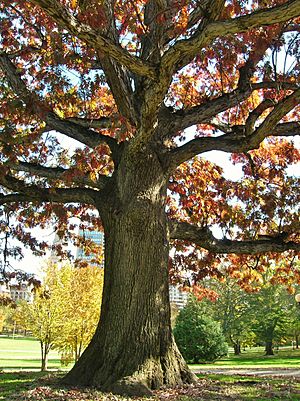Bushnell Park facts for kids
Quick facts for kids |
|
|
Bushnell Park
|
|

Print celebrating completion of the Soldiers and Sailors Memorial in 1886 by Kellog & Bulkeley print company
|
|
| Location | Bounded by Elm, Jewell, and Trinity Sts., Hartford, Connecticut |
|---|---|
| Area | 37 acres (15 ha) |
| Built | 1868 |
| Architect | Weidenmann, Jacob |
| NRHP reference No. | 70000692 |
| Added to NRHP | October 22, 1970 |
Bushnell Park in Hartford, Connecticut, is a very special place. It's the oldest park in the United States that was paid for by public money! The idea for this park came from Reverend Horace Bushnell in the mid-1850s. Back then, people were just starting to realize how important open public spaces were.
Today, the park covers about 50 acres of green space. Over one million people visit it every year. Paths through the park are even part of the East Coast Greenway, a huge trail system!
Contents
Park History
Hartford's Busy Past
In the 1850s, Hartford was a very busy river town. Its population grew super fast, doubling between 1850 and 1860! The city's economy was booming thanks to industries like publishing, insurance, and manufacturing. Hartford was enjoying the benefits of the Industrial Revolution.
But with all this growth came some challenges. The city had crowded homes, pollution, and poor sanitation. It was in this busy, sometimes messy, environment that Reverend Bushnell had a big idea. He suggested creating a public park, paid for entirely by the city's money. This was a brand new idea for any American city!
A New Idea for a Park
At first, many people were unsure about Bushnell's idea. Business leaders worried about losing land that could be taxed. Also, the spot Bushnell suggested for the park was not pretty at all! It had smelly leather factories, soap-making shops, and even a garbage dump. There were pigsties and other farm animals. A railroad track ran through it, and the Park River nearby was full of the city's industrial waste. Even Reverend Bushnell called it "hell without the fire."
However, after hearing Dr. Bushnell's presentation in October 1853, the Hartford City Council agreed. They voted to use public money to buy the land for the park. On January 5, 1854, Hartford voters approved the plan by a large margin. This made Bushnell Park the first city park in the nation to be created and paid for by citizens through a public vote!
Designing the Park
Even after the vote, the park didn't take shape right away. Six years later, Reverend Bushnell asked his friend, Frederick Law Olmsted, to design the park. Olmsted was a famous landscape architect from Hartford. But he was busy designing New York City's Central Park and Forest Park in Springfield, Massachusetts.
So, Olmsted suggested Jacob Weidenmann, a landscape architect and botanist from Switzerland. Weidenmann's plan for Bushnell Park included beautiful paths and groups of trees. These trees helped block city noises and made the Park River, which flowed through the park, a more important feature.
Park Features and Changes
Over the years, many wonderful additions have been made to Bushnell Park:
- The Horace Wells Monument was added in 1875.
- The impressive Soldiers and Sailors Memorial Arch was designed in 1886. It honors those who fought in the American Civil War.
- The Corning Fountain was installed in 1899.
- A fun carousel was brought to the park in 1974. It plays music from a special Wurlitzer Band Organ!
- A performance pavilion was built in 1995 for concerts and events.
Because of flooding and pollution, especially after a big flood in 1936, the Park River was eventually buried underground. This meant a main water feature of the park was lost. Later, a pond was added to bring water back to the park. Since 2017, this pond has been home to Horace, a Great Blue Heron. The local community lovingly named him after Horace Wells and Horace Bushnell.
Today, Bushnell Park is a central spot in downtown Hartford. It hosts many festivals and music events throughout the year. The park was added to the National Register of Historic Places in 1970, recognizing its importance.
Images for kids





